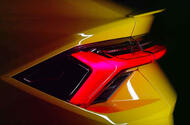Lamborghini Urus: latest video shows Asterion design link

A new video shows the car's rear light designUpcoming Urus is claimed to be the fastest and sharpest SUV yet; anti-roll system reduces body roll by applying torque to the suspension
A new video of the Lamborghini Urus has been released showing more parts of its design in the run up to its December reveal.
For the first time the car's thin taillight strip is shown, sporting a design that looks similar to that of the Asterion - Lamborghini's shelved hybrid supercar.
Lamborghini wants its new Urus to be the market's fastest and sharpest SUV when it launches in the coming days; it has recently released a video to demonstrate the car's dynamic abilities.
Footage of the car being driven aggressively on circuit (below) illustrates the car's 48V-powered active anti-roll suspension technology, which is most effective when the car is set to Corsa (track) mode.
The system, which is related to the one fitted to the Bentley Bentayga (the Urus uses the same platform, as does the Audi Q7), reduces body roll by applying torque to the suspension to counter lean. It works with the car's torque vectoring technology and four-wheel steering to boost agility.
Lamborghini is also keen to emphasise that its high-performance SUV can be driven off-road. The brand has previously released footage of the Urus making use of its traction-boosting driveline technology on low-grip surfaces. It features a traction control system with six separate settings: Strada (road), Sport, Corsa (track), Sabbia (sand), Terra (dirt), and Neve (snow).
The Urus range will feature the brand's first plug-in hybrid powertrain, R&D chief Maurizio Reggiani confirmed. It will be the only hybrid in the Lamborghini line-up (until a PHEV Huracán arrives in 2022) and be offered alongside a twin-turbocharged 4.0-litre V8 Urus.
Lamborghini has chosen not to use a naturally aspirated powertrain for its SUV, despite prioritising atmospheric induction in its supercars, because it believes SUVs need to have huge torque.
“A super sports car is completely different; you need the responsiveness of the engine, to feel the spark of every cylinder," said Reggiani. "We will keep normally aspirated engines for our other models – they are still the best choice.”
Lamborghini’s first SUV since the LM002 (1986-1993) will be revealed on 4 December before production begins at the brand's Sant’Agata Bolognese site in northern Italy. The site has recently undergone major construction work and the workforce is being expanded to prepare for an anticipated surge in demand.
In the run-up to the car's reveal, Reggiani claimed that the Urus's design, although applied to an unfamiliar bodyshape, is "pure Lamborghini". He said the look "has evolved considerably since the [2015] concept and the finished car is much better inside and out".
Reggiani said Lamborghini has concentrated its R&D efforts on power, weight and aerodynamics, because “handling is a function” of these. “We want to be a leader here and have a chance to change the rules of the game,” he added, alluding to new, as-yet-undisclosed developments that are now believed to be linked to the car's anti-roll system.
Reggiani said he sees a strong distinction between the firm’s four-wheel-drive models and the growing number of rear-wheel-drive variants. A modern electronic chassis control system like that of the Huracán LP580-2 is no substitute for the ability of four-wheel drive to transfer power to the road, he explained. Lamborghini will therefore continue to offer both driveline systems.
Additional reporting by Sam Sheehan
Comments
Post a Comment